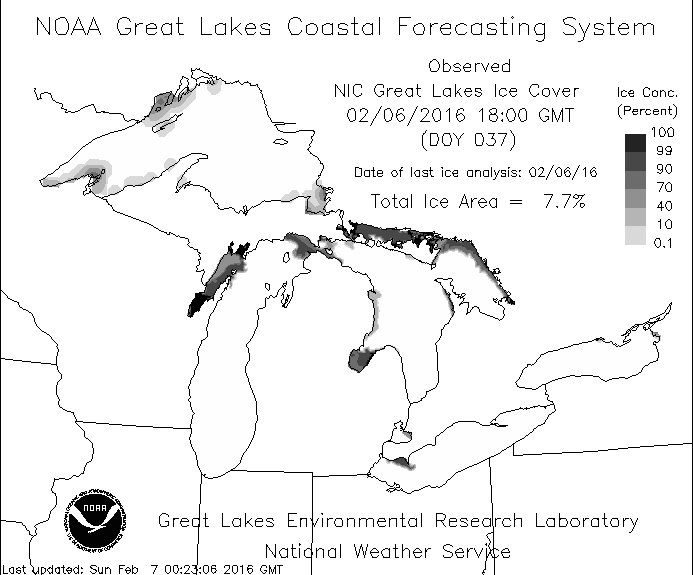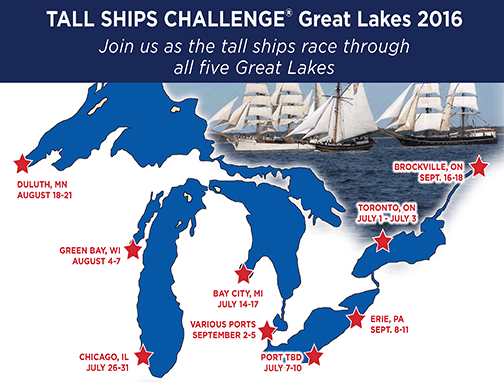| Back to Back Issues Page |
 |
|
Rhumb Line, Vol 4 Issue 1 -- New at www.great-lakes-sailing.com February 08, 2016 |
Rhumb Linea course that keeps a constant bearing
The Rhumb Line for Great Lakes Sailing is clear: to provide a comprehensive listing of ports around the Great Lakes basin and articles that cover a broad range of topics of interest to sailors. The purpose of Rhumb Line is to keep you up-to-date with new additions to Great Lakes Sailing and articles of interest in a brief, easy-to-scan and concise manner. I value not only your interest but also your time. January 2016 New at Great Lakes Sailing 1. New Ports 2. Toronto International Boat Show 3. Why We Sail 4. Ice Cover on the Great Lakes 5. Tides at Napanee ON? 6. Light Lists 7. Tall Ships Challenge 2016 1. New Ports (a) Northport, MI is considered by many local sailors to be one of the top harbors in the Grand Traverse area. It is located up the Leelanau Peninsula, the largest cherry growing region in the United States. Vineyards abound as well. Northport is a popular destination for cruising sailors. Click here to visit
Northport, MI.
Today, it is a very popular destination for cruising sailors. To read more about this interesting island and its fascinating history, click here to visit
Beaver Island MI.
My underlying theme has always been that these Great Lakes are a phenomenal inland sea system and that we are so blessed to have them at our doorsteps (some 'steps' might be longer than others!). My goal is to encourage people to go out and explore them and see first-hand all they have to offer. From feedback I have received both at the show and afterwards, I expect there will be more people next year with neat experiences to share and stories to tell. Thanks to all who introduced themselves to me – its great to be able to put a face to a name and share some thoughts. In February, I will be speaking at Cathedral Bluffs Yacht Club (Toronto) and at a safety seminar at Fogh Marine (Toronto). If any reader
is there, please say 'hello' – it is great to meet each of you.
Turning this question over in my mind was an interesting exercise. I love John Masefield's poem “Sea Fever”. It speaks so much to the feeling of sailing. So here go my reasons why I sail. And, I invite you to send me in your thoughts – if you are willing, I will include your responses in the next issue. (And sailing refers to being 'out there' – whether on a traditional sailboat or powerboat!) Sailing makes me me feel alive. To move, to reach any destination – near or far – demands that you be in tune with the world around you. The sky, sea state, wind all tell their story and, learning to read, to
hear their 'story', means that you can dance with nature. Feeling the wind on my face is bewitching. Imagine – everything that we do on a sailboat is driven by the wind. In fact, wind is the great engine of the world. It drives weather. Yet, it's invisible! The next time you see a flag streaming from its pole, try to see not the flag but the river of air that is moving past it. Or, noticing cats paws on the water, try to see the currents of moving air sweeping over that water. Whether the gossamer threads of cirrus clouds or grey clouds scudding across a leaden sky, try to see the torrents of moving air that drives them. Wind makes me look for things that aren't readily apparent. And seeing them, makes me feel more alive. This is why I sail.
A diminished ice cover results in warmer waters and this can trigger algae blooms, for example on Lake Erie. Reduced ice cover can also contribute to lower water levels due to evaporation. Nothing in nature happens in isolation. 
5. Tides at Napanee ON? One of the enjoyable things about speaking to various groups are the people I meet and the stories they have to share. After I presentation, I was asked if I was aware of the Napanee (ON) tides. I said I wasn't but that I did know there were minute tidal movements on the Great Lakes but nothing that had to be taken into account. I was assured that there were indeed measurable tides on the Napanee River that occur on a very regular basis. The explanation I was given follows here. When there are steady winds across Lake Ontario from the southwest, they push water to the northeast shore. This phenomenon is known as 'fetch'. Naturally, when the wind slackens, the water surges back to where it came from. This 'rebound' is known as 'seiche'. This occurs over fixed period of time, taking about to 2 hours for a one-way surge between Rochester and the Bay of Quinte, a distance of 110 km. The seiche repeats itself again and again and can go on for several days. The important driving function causing the tidal effect on the Napanee River is the wind. Also key to this effect is the length of the river. The tide runs upriver for approximately 1 hour, peaks and then ebbs back into Lake Ontario. The tide is generally between 6" and 16" (15 cm to 41 cm). This 2 hour ebb and flow coincides with the 2 hour surge and seiche across the lake resulting in a very unique natural phenomenon. If the river were any longer or shorter, it wouldn't work. Talk about nature in harmony!
The official Light Lists for Great Lakes waters of both countries are available in the Free Resources section
here.
 7. Tall Ships 2016
7. Tall Ships 2016Nothing speaks to the romance of sailing as the sight of a tall ship, her sails full and a wave curling past her bow. Well, if that stirs your soul, get ready to enjoy another Tall Ships spectacle on the Great Lakes this summer. Tall Ships America is bringing the Tall Ships Challenge to all 5 of the Great Lakes this summer. The accompanying illustration shows where you can see these great sailing ships. Thanks for reading Rhumb Line. Your opinions, thoughts and comments do matter. If you have any comments or questions, please feel free to contact me here at Rhumb Line or at Great Lakes Sailing. If you like this newsletter, please do a friend and me a big favour and "pay it forward." If a friend DID forward this to you and if you like what you read, please subscribe. You will find a subscribe button on most pages of the site. |
| Back to Back Issues Page |